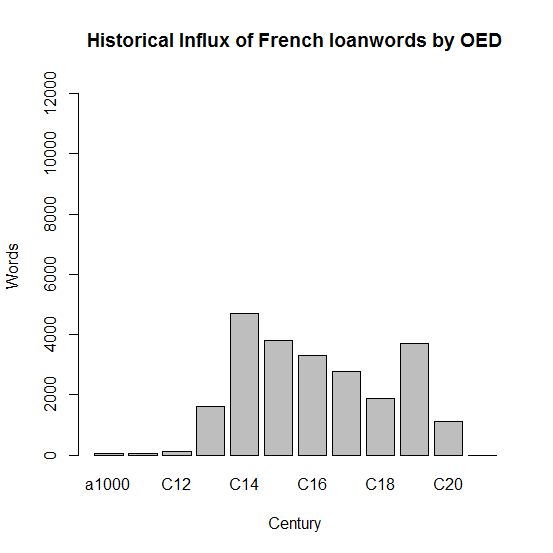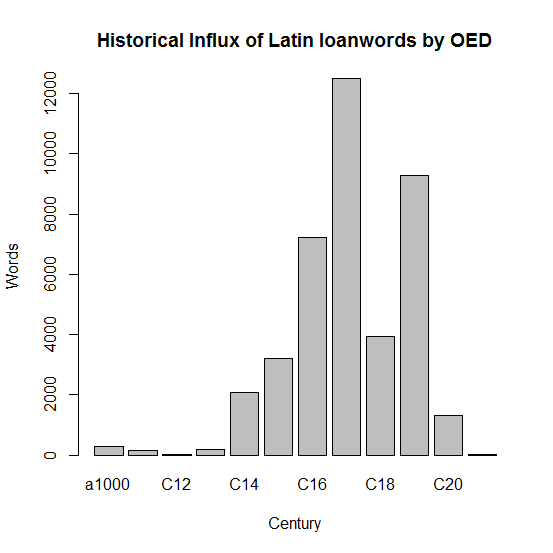英語史におけるラテン語借用については,latin loan_word の幾多の記事で取り上げてきた.古英語期以前のラテン借用については,「#32. 古英語期に借用されたラテン語」 ([2009-05-30-1]) で簡単な時代別の分類に触れ,いくつかの例を挙げたにすぎないので,今回はもう少し例を挙げてみたい.
Crystal (59--65) では,古英語以前のラテン語借用を,Serjeantson (Appendix A) にしたがって (1) 大陸時代,(2) c. 450--c. 650, (3) c. 650--c. 1100 と時代別に3区分している.以下に,それぞれの時代を代表する例をいくつか挙げよう.
(1) 大陸時代
belt (belt) < L balteus
butere (butter) < L butyrum
camp (field, battle) < L campus
candel (candle) < L candela
catt (cat) < L cattus
ceaster (city) < L castra
cetel (kettle) < L catillus
cupp (cup) < L cuppa
cycene (kitchen) < L coquina
cyse (cheese) < L caseus
draca (dragon) < L draco
mæsse (mass) < L missa
mil (mile) < L mille
minte (mint) < L menta
munuc (monk) < L monachus
mynster (minster) < L monasterium
panne (pan) < L panna
piper (pepper) < L piper
pise (pea) < L pisum
plante (plant) < L planta
port (door, gate) < L porta
port (harbour, town) < L portus
pund (pound) < L pondo
sacc (sack, bag) < L saccus
sinoð (council, synod) < L synodus
stræt (road) < L strata
tigle (tile) < L tegula
weall (wall) < L vallum
win (wine) < L vinum
ynce (inch) < L uncia
(2) c. 450--c. 650
cocc (cock) < L coccus
cugle (cowl) < L cuculla
cyrtan (to shorten, curtail) < L curtus
forca (fork) < L furca
fossere (spade) < L fossorium
græf (stylus) < L graphium
læden (Latin) < L ladinus (Vulgar Latin)
leahtric (lettuce) < L lactuca
mægester (master) < L magister
nunne (nun) < L nonna
pere (pear) < L pirum
pinsian (to reflect, consider) < L pensare
punt (punt, flat boat) < L ponto
relic (relic) < L reliquia
renge (spider) < L aranea
seglian (to seal) < L sigillare
segn (mark, sign) < L signum
stropp (strap) < L stroppus
torr (tower) < L turris
turl (ladle, trowel) < L trulla
(3) c. 650--c. 1100
alter (altar) < L altar
biblioþece (library) < L bibliotheca
cancer (crab) < L cancer
creda (creed, belief) < L credo
cucumer (cucumber) < L cucumer
culpe (guilt, fault) < L culpa
diacon (deacon) < L diaconus
fenester (window) < L fenestra
fers (verse) < L versus
grammatic (grammar) < L grammatica
mamma (breast) < L mamma
notere (notary) < L notarius
offrian (sacrifice, offer) < L offere
orgel (organ) < L organum
papa (pope) < L papa
philosoph (philosopher) < L philosophus
predician (preach) < L praedicare
regol (religious rule) < L regula
sabbat (sabbath) < L sabbatum
scol (school) < L scola
Serjeantson のリストによれば,(1) には183語,(2) には114語,(3) には244語が挙がっているが,各語の時代区分の正確性は必ずしも保証されておらず,額面通りに受け取るには注意を要する.だが,単語の意味領域について一般的にいえば,(1) は日常語を含む幅広い意味領域を覆っているが,(2) では宗教的な色彩が見え始め,(3) では宗教に加え学識を感じさせる単語が多い.キリスト教の伝来を契機に,ラテン借用語の質が変化したことを見て取ることができる.借用の媒介に関しても,(1) や (2) は主として話し言葉から入ったが,(3) は主として書き言葉を通じて流入したと想定される.
上記のリストでは,主に現代英語まで残ったラテン借用語を挙げてあるが,実際には現代英語にまで生き残らなかったものも多い.現代標準英語に残っているのは,約100語くらいのものである.大多数が後に死語となった背景には,中英語期に同義のフランス借用語が流入したという事情がある.新しくて格好のよいフランス語が,古めかしいラテン語に取って代わったのである.ただし,現代まで残っているラテン借用語の多くは,本来語彙と同じぐらい盤石に英語語彙に根付いている.
なお,古英語期以前に同一のラテン単語が2度借用された例もあるので,触れておこう.L calicem は "cup" の意味で最初に celc として,後に calic として古英語に借用された.同様の例を挙げる.
cliroc, cleric (cleric, clergyman) < L clericus
læden, latin (Latin) < L latinus
leahtric, lactuca (lettuce) < L lactuca
minte, menta (mint) < L menta
spynge, sponge (sponge) < L spongea
・ Crystal, David. The Stories of English. London: Penguin, 2005.
・ Serjeantson, Mary S. A History of Foreign Words in English. London: Routledge and Kegan Paul, 1935.
[
|
固定リンク
|
印刷用ページ
]

